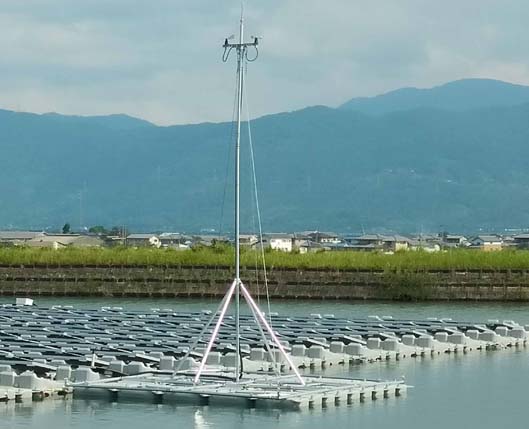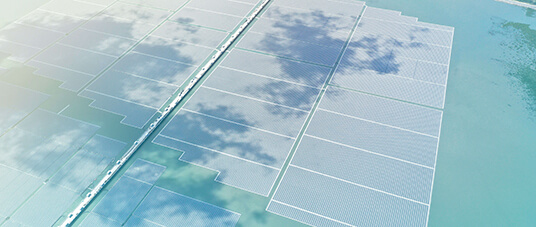QUESTIONS ?
WE HAVE THE ANSWERS.
THE MOST CONSULTED TOPICS
The most viewed topics
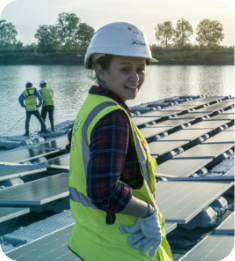
General
questions

Product
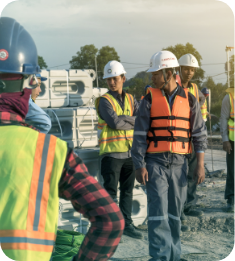
Site conditions
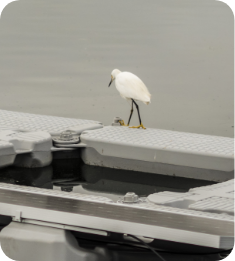
Environmental
impacts

Floating pv
design
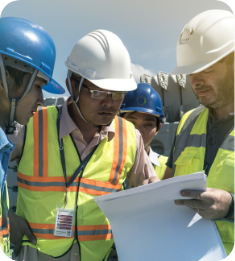
Electrical spec.
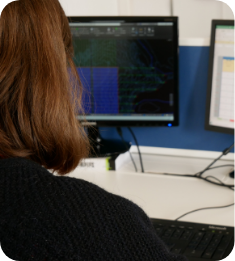
Anchoring
design
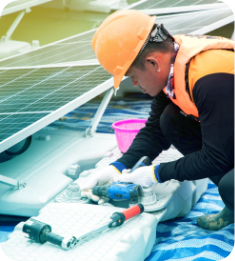
Construction
General Questions
What is the yield compared to ground PV plants?
The Solar Energy Research Institute of Singapore (SERIS) observed a PV panel temperature 3 to 10 degrees lower on floating PV plants compared to rooftop systems in Singapore with a yield increase of 5 to 10%.
Moreover, the Solar Energy Application Centre (SEAC) recorded a decrease up to 6 degrees in PV panels temperature in the Netherlands with a yield increase estimated at 2 to 3%.
Per hectare, what is the installable capacity?
We estimate that a 1MWp floating PV plant occupies approximately 1ha on the water body.
In addition, it is important to respect a distance between the floating arrays and the banks. Meaning that the maximum coverage ratio of the water body is 65% on average.
Where can I purchase floating solar products?
First, you can fill out our contact form,, and you will be in contact with our closest Sales Department, which will help you establish your project’s technical and financial feasibility.
Then, our Sales team will handover our project to our Engineering team to execute the detailed anchoring design. At the project implementation phase, we take care of the on-site delivery of our floating solar system. Afterwards, we organize an on-site training session with our construction engineer to explain the assembly process to your teams.
Where are your products manufactured?
We manufacture our products in France, the USA, Brazil, Japan, South Korea, Thailand, India, Malaysia, Taiwan etc. For large scale projects, we may consider local manufacturing.
For more details, please, refer to the Supply and Procurement service page.
What are the selling points of our floating PV products?
- We are pioneers in the floating PV market since 2011 with the widest track record in terms of number of projects installed worldwide. Thanks to our experience, we offer the most suitable technical advice and solutions.
- Our technologies are tested by third parties and in our own laboratory to ensure the quality of the FPV system we provide.
- We offer solutions adapted to their markets. Since our first floating PV pilot in 2010, we have developed our products and our floatting solar services to answer your specific needs. Now, we provide many options regarding floating products, plant configurations and anchoring systems.
- With 10 offices, 3 licensees and 40 manufacturing sites all over the world, we ensure worldwide distribution and personalized support as close as possible to our customers and their floatting solar projects.
- Throughout the project development and implementation, we will help and assist you technically with a wide range of service.
- We offer cost competitive solutions developed to be price-competitive in their market while ensuring quality of materials and products.
What is the delivery time?
Do banks financially support floating PV projects?
Yes, many of the floating PV plants built in the world have been financed and supported by banks. This includes some of the world’s top-ranked banks. For example, in Japan, projects have been financed by both national and regional banks. Namely, in France, the 17 MWp O’MEGA1 project has been financed with around €12 million of non-recourse financing.
What is the product standard warranty of our systems?
We offer a 10-year warranty for our FPV systems, to cover replacement and repair of any potential defective component of the product. Additionally, an extension of additional 5-, 10- or 15-year warranty can be discussed.
How is O&M done on the floating PV arrays?
First of all, there are maintenance walkways between PV panel rows allowing operators to walk easily on the floating PV plant to do O&M tasks such as PV panels cleaning and parts replacement.
In addition to operation, preventive and corrective maintenance tasks must be considered. Furthermore, we provide an O&M manual, including checklists and controls, to our clients prior to plant operation.
Also, the maintenance of the floating structure and its anchoring system can also be done by our team. Discover our maintenance services, or contact us to learn more about our offers.
Product
What are the components of Ciel & Terre's floating structures?
Floats are made of HDPE (High Density Polyethylene), connection pins are Polypropylene and PV panel fixation is Aluminum. Additives are added to the raw materials to ensure the product lifetime.
Can the color of the floats be changed?
Float color cannot change. Indeed, the grey color of the floats allows UV resistance and light reflection.
What is the buoyancy of Ciel & Terre's floating structures?
What are the possible tilts for Ciel & Terre's floating solar systems?
DOES CIEL & TERRE HAVE A SOLUTION TO PREVENT BIRD EXCREMENTS FROM DECREASING THE PANEL’S YIELD?
What tests do you conduct to determine Ciel & Terre's floating structure resistance?
We test our floating structures and their fixation with mechanical tests (fatigue and static) and wind tunnel tests by 3rd party institutes and also in our own test laboratory. To learn more about our testing policy, please visit our product page: Discover our tests.
Are Ciel & Terre's floating solar systems certified?
As floating solar is a recent concept, there is no certification regarding the floats yet. However, we base our test protocols on relevant standards. For example, we have obtained certifications for drinking water compliance. In addition, Bureau Veritas has certified our design methods.
What is the lifetime of Ciel & Terre's floating solar structures?
Site conditions
How to identify water bodies where floating solar can be installed?
At Ciel & Terre, we wish to preserve the environment and recommend studying floating PV projects on artificial water bodies.
Ideal water body characteristics are:
- Regular shape
- Limited depth and water level variation
- Road access
- Space on the banks for construction and storage
- Proximity with the grid is a plus for the project development
But, almost any water body could be a candidate for floating solar. We are happy to assess your site at no cost to you. Contact us
Can Ciel & Terre's floating solar structures be installed on drinking water ponds?
Our floats are made of HDPE (High Density Polyethylene) which has a neutral impact on water.
They are compliant with the standard BS 6920:2000 (odor & flavor test for non-metallic material for use with drinking water), which proves that it is suitable for contact with water intended for human consumption.
Can Ciel & Terre's floating solar structures be installed on salty waters?
The floats are made from HDPE (High Density Polyethylene) and salty water has no effect on this material. We choose the raw materials of metallic pieces to withstand salinity. We are developing a solution that can withstand salinity.
The PV panels and electrical equipment will also need to resist these conditions.
An appropriate O&M plan, especially regarding the electrical parts, will have to be considered.
Can Ciel & Terre's floating solar structures be installed on polluted waters?
A water quality analysis will be required to check that our floating solar systems can be installed safely. The EPC should also check the feasibility of the project regarding the electrical equipment.
Can Ciel & Terre's floating solar structures resist to high winds?
We have designed our floating solar structures so that they withstand winds up to 210 km/h (130 mph).
Then we design the floating PV plants case by case and we define its anchoring with the Client, according to site conditions.
Can Ciel & Terre's floating solar structures be installed on oceans or seas?
Our floating solar structures are not suitable for harsh offshore conditions. However, they can be installed on closed seas or lagoons where water current, tides and waves are limited.
Can Ciel & Terre's floating solar structures be installed in cold environments (frost and snow)?
What happens in case of drought?
If the water body bottom is not flat or has some obstacles (pipes, rocks…), the site is not eligible due to the risk of damage to the floating system. Contact our teams to evaluate the feasibility of your project. Contact us
Can Ciel & Terre's floating solar structures be installed if there is a risk of overflow?
However, Ciel & Terre must be informed of potential overflow in order to consider it when executing the anchoring design.
Are Ciel & Terre's floating solar structures compatible with fishing and fish farming?
An environmental study by a specialized consultant will allow Ciel & Terre’s engineers to design the floating PV plant to preserve fishing and fish farming.
Environmental impacts
Does floating solar prevent algae growth?
An environmental consultant can help you assess the impact.
Do your floating PV technologies prevent evaporation?
Since we cover or shadow a significant part of the water body with the floating PV plant, as a consequence you can expect a reduction of evaporation. However, it might be difficult to quantify the phenomenon as it is very specific to climate conditions.
What is the impact of our FPV structures on aquatic life?
What is the impact of your solutions on water quality?
Our floats are made of HDPE (High Density Polyethylene) which has a neutral impact on water. Indeed, our systems are compliant with the standard BS 6920:2000 (odor & flavor test for non-metallic material for use with drinking water) which proves that it is suitable for contact with water intended for human consumption.
Are there any permanent effects on the site’s environment after the operation decommissioning the plant?
Are your technologies recyclable?
HDPE is a recyclable material. For instance, there is a set of profitable channels for the use of recycled HDPE. Moreover, aluminum parts are also recyclable.
We recommend complying with local electric standard.
On the Hydrelio® products, PV panels grounding holes are used to do the grounding between PV panels.
Is there any limitation of size or capacity?
There is no limitation of size for a whole floating PV plant. However, because of anchoring reasons, there is a limitation for an individual solar array. Thus, we design big-scale projects with several single arrays.
As an example, the 70 MWp project of Anhui Cecep (China) is composed of 13 floating PV arrays. See project
What is the buoyancy of Ciel & Terre's floating solar structures?
We have designed the floats to enable operators to move easily on the floating PV array and safely carry out O&M.
Can the floating PV arrays move and hit the banks?
Because it is anchored with several anchors on each side, the movement of the floating PV array will be limited. During the anchoring design execution, the Engineering team calculates the movement of the floating PV plant and ensures that it won’t hit the banks.
What happens when the water level drops?
We design the floating PV array and anchoring to adapt to water level variation. Due to the slack of the mooring lines, the floating PV array will move on the surface according to the magnitude of the water level variation.
What PV panels orientations are possible with Ciel & Terre's floating structures?
Depending on the products chosen, our teams can advise you different solar panel orientations:
- Conventional (north-south configuration)
- Dual orientation or duo pitch (east-west plant configuration)
Sun-tracking is not available.
Are all the PV panels compatible with Ciel & Terre's floating solar structures?
The floats are compatible with most PV panels available on the market, up to 670 Wp so far.
For our Hydrelio® system, PV panels are assembled with the main floats.
Can frameless PV panels be installed on Ciel & Terre's floating solar structures?
We primarily design our floating solar structures for framed PV panels but solutions to fix frameless PV panels can be found depending on the configuration. Frameless PV panels are, however, more fragile and thus, less adapted to floating PV plants and the environmental challenges.
How to install the electrical cables between the floating PV arrays and the banks?
Based on our experience and collaborations with electrical engineers, we recommend 2 options:
- UV resistant-electrical conduits fastened on isolated floats between the floating arrays and the banks
- UV resistant floating conduit with electrical cables inside.
Is it safe to have PV panels connectors in contact with water?
We recommend reducing risks of contact with water by attaching DC cables to the PV panels before the launching of floats on water, by using stainless steel clips for instance.
What is the information required for the plant design?
For a first site assessment, the information we require are
- The GPS coordinates of your site
- The site conditions including: pond type, water type, max depth and water level variation
- The electrical equipment main features.
These data will allow our engineering teams to determine the exploitable surface of the pond and the maximum capacity for your floating PV plant. Contact us
Electrical specifications
How does water proximity impact electricity generation?
Water proximity is an advantage for your floating plant.
Water provides a natural cooling effect when the production is at its maximum. This phenomenon reduces the temperature variation peaks thus provides a cooler environment. This cooling effect enables PV panels to generate more power.
HOW IS THE PV PANEL CABLING DONE?
The construction team does PV panel cabling on the banks during the assembly of the floats and PV panels. These groups are then connected by string, then several strings are connected together before being pushed onto water.
Cables are connected behind the PV panels and fixed to the frame to avoid any contact with the water.
Is it safe to have PV panels connectors in contact with water?
We recommend reducing risks of contact with water by attaching DC cables to the PV panels before the floats are launched on water, by using stainless steel clips for instance.
We also recommend to used watertight and UV-resistant cable conduits.
Does the material need to have a BOS specification (weight, IP code, size)?
We suggest using at least IP 66 equipment. Regarding the weight, the lightest the equipment are, the better.
Because of permanent movement, cables suppliers recommend using copper cables.
The EPC must observe possible local regulations regarding electrical equipment.
Are the inverters installed on the floating PV arrays?
In most cases, plants are designed with central inverters located on the banks and junction boxes on the floating PV arrays.
Depending on the product chosen, it is also possible to install string inverters on the floating PV arrays. Our project engineering team can advise the EPC regarding this matter.
How does grid connection work for floating PV plants?
The grid connection of a floating PV plant works the same way as a ground-mounted plant.
What are the recommendations for earthing/grounding?
We recommend complying with local electric standards.
With our Hydrelio® solution, PV panels grounding holes are used to do the grounding between PV panels.
How can I protect the DC cables?
Because of UV exposure and permanent movement of the floating PV arrays, we recommend using UV resistant flexible conduits.
How to install the electrical cables between the floating PV arrays and the banks?
Based on our experience and collaborations with electrical engineers, we recommend 2 options:
- UV resistant-electrical conduits fastened on isolated floats between the floating arrays and the banks
- UV resistant floating conduit with electrical cables inside.
Anchoring design
What is the information required for the anchoring design?
The anchoring design is executed at an advanced stage of the project planning, when the final floating array design is approved. The critical data to perform an anchoring design are:
- Topography of the banks
- Bathymetry
- Water level variation (over the lifetime of the plant)
- Waterflow data if there is any wind speed on site is calculated from national building code and approved by the client.
What are the possible anchoring systems?
- Anchoring at the bottom of the reservoir
- Bank anchoring
- Hybrid anchoring mixing banks and bottom anchoring
What type of anchors can we use for the FPV project?
At Ciel & Terre, we propose three main types of anchors: drilled anchors, percussive anchors and concrete blocks.
Nevertheless, if none of these anchors can be used, our engineering team will study other types of anchors.
How does water level variation impact the anchoring system?
Therefore, it is highly critical to perform the anchoring design with accurate and reliable data, so the anchoring system is safe at any water level.
Can the floating PV arrays move and hit the banks?
Because it is anchored with several anchors on each side, the movement of the floating PV array will be limited. During the anchoring design execution, our engineering team calculates the movement of the floating PV plant and ensures that it won’t hit the banks.
Can the floating PV plant lie on the bottom of the reservoir?
In case of droughts, floats will lie on the bottom of the water body without being damaged.
If the water body bottom is not flat or has some obstacles (pipes, rocks…), the site may not be eligible due to the risk of damage to the floating system.
What is the resistance of the anchoring system?
We design our anchoring systems to resist environmental loads: wind, waves, current.
Firstly, we calculate the wind loads thank to several technics : with CFD, with wind tunnel tests and with wind speed calculated from national building code. Secondly, we measure wave loads based on the floating solar island, reservoir layouts and wind speed. Finally, we analyze waterflow loads based on the FPV array and reservoir layouts and waterflow data.
Do the mooring lines rust?
Depending on site conditions, for instance salty water can be one of them, we choose and select the right equipment accordingly. Usually, to mitigate the risk of corrosion, we use galvanized steel cables and polyester ropes.
Does Ciel & Terre supply the anchoring and mooring systems?
Firstly, we define the location of each anchor and the applicable load on each anchor and each mooring line length. In addtion, we provide the anchoring material specifications too.
Secondly, and as the floating solar expert with a strong experience in anchoring, we provide you the support you need to ensure your floating PV plant is correctly anchored.
Finally, our construction team manage the supply and the installation of the anchoring system.
Click on the following link to discover our services: Discover our services, or contact us to learn more about our offers: Contact us.
HOW IS FLOATING PV ARRAY MOVEMENT AVOIDED DURING CONSTRUCTION?
First of all, we begin with the installation of the anchoring system prior to float assembly and connected to FPV blocs during the installation. Then, we install additional temporary anchors and mooring lines to maintain the arrays. For this reason, the temporary anchoring system must be as resistant as the final anchoring.
Construction
How to mount our floating solar systems in case the banks are too steep?
If the banks are too steep, we can install a wooden platform with scaffolding to reduce the banks’ slope for safety reasons.
Is there a minimum size for the construction area?
How to assemble the Hydrelio® floating PV array?
- Manuals and supporting documents
- A training session on site at the start of the assembly
- Advice to increase the assembly efficiency
- Construction drawings in order to ease construction for the installation team
In addition, we can also manage the construction of the floating solar island and its anchoring. You can contact us to have more details and visit our services page to learn more about our construction services : Discover our services.
How many people do we need to install a floating solar plant?
Which tools do we need to install a FPV structure?
Actually, the use of tool will depend on the type of floating solar structure you will select for your project.
Considering our Hydrelio® system, you won’t need heavy or specific tools to assemble the platform nor the PV panels on the floats. Moreover, during the planning phase our project manager will provide a list of tools that you will need to install our solution. In addition, a boat and all the adapted protective equipment (PPE) such as life jackets, helmets, security boots, etc. are mandatory.
How do you launch the floating PV arrays on the water?
How long does it take to install a floating PV plant?
How do you avoid the Hydrelio® floating PV arrays moving during the work?
How to secure floating PV plants?
- Video surveillance / CCTV next to the electrical installation on the banks
- Fencing the land
- Installing a floating barrier around the floating PV plant
Is there a training session for the installation?
At Ciel & Terre, we provide a training session on site at the start of the assembly and give advice to increase the assembly efficiency. In general, the typical duration is 2 days and can be adapted depending on your needs. Our construction team can also support you with the installation of the floating solar plant and its anchoring.
To learn more about our Services: Discover our services.
OUR ARTICLES, TO GO FURTHER…

Ciel & Terre adapts anchoring to floating solar projects constraints
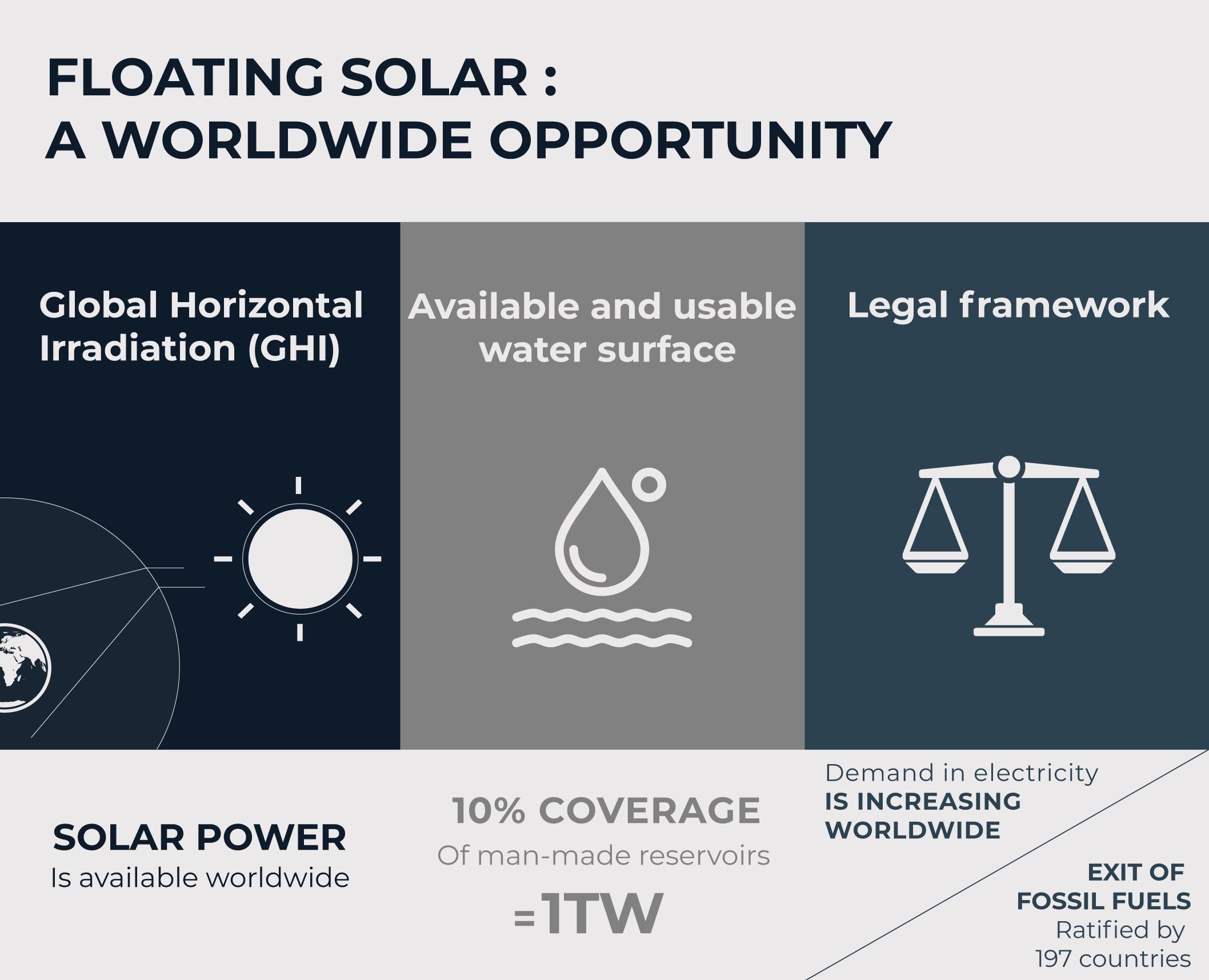
Floating solar-friendly ponds: what are they?
